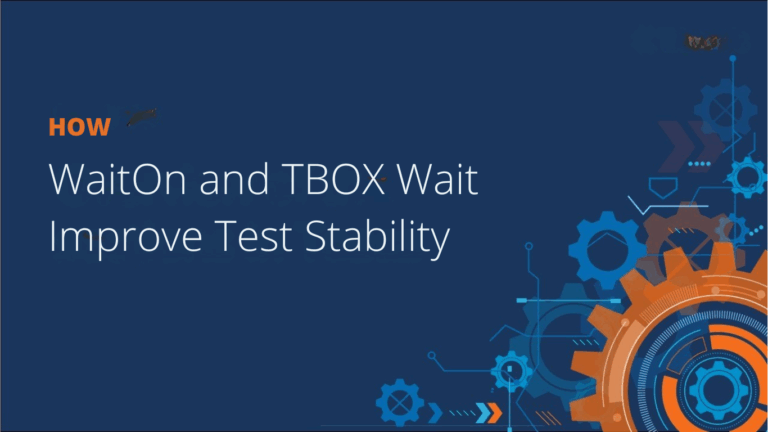Introduction:
Stability is the key to achieving reliable and effective results in test automation. Automated tests often break due to unexpected delays in UI rendering, dynamic content loading, or fluctuating network responses. These inconsistencies can lead to false negatives, reduced trust in test results, and costly debugging sessions. This is where intelligent wait strategies come into play.
In TOSCA Automation, mastering the concepts of WaitOn and TBOX Wait is vital for achieving reliable, robust, and efficient test executions. Whether you’re preparing for TOSCA Certification Online, enrolled in TOSCA Training Online, or enhancing your skills through a TOSCA Automation Course Online, understanding wait mechanisms is non-negotiable.
This guide will walk you through the key concepts of static and dynamic waits, especially TBOX Wait and WaitOn, and show how they directly contribute to test stability via timeout management.
Understanding Waits: Dynamic vs Static
Static Waits: Fixed Delays
Static waits use a pre-set pause before continuing to the next step. In TOSCA, these include:
- TBOX Wait: A fixed duration set explicitly in milliseconds.
- WaitBefore and WaitAfter: Steering parameters used at the module attribute level or module level to introduce delays before or after a test action.
These are useful in scenarios where UI load times are consistent and predictable but can lead to inefficiencies if overused.
Dynamic Waits: Condition-Based Pauses
Dynamic waits, unlike static waits, pause the test only until a specific condition is met or a timeout limit is reached. In TOSCA, this is implemented using the WaitOn action mode.
Rather than halting for a fixed time, this method checks the control’s state or value and proceeds as soon as the expected condition is satisfied, enhancing performance and stability.
TBOX Wait: Static Synchronization Simplified
What Is TBOX Wait?
TBOX Wait allows testers to halt the test execution for a fixed number of milliseconds. It’s useful for inserting deliberate pauses where automation interacts with slow-loading components.
Example:
Add TBOX Wait for 3000 milliseconds before clicking “Submit”.
When to Use It
- Interacting with static-heavy UI elements.
- Allowing transitions or animations to complete.
- Temporarily halting execution where dynamic waits are not feasible.
However, overusing this feature can significantly slow down test execution.
WaitBefore and WaitAfter: Fine-Tuning Static Waits
These are module-level steering parameters used to add delays around actions:
- WaitBefore: Waits before an action begins.
- WaitAfter: Waits after the action completes.
Both are especially useful in handling short transitions or intermediate processes like loading spinners or pop-ups.
WaitOn: Smarter, Dynamic Synchronization
What Is It?
The WaitOn action mode is TOSCA’s built-in feature for dynamic waiting. Rather than relying on time-based halts, it watches the state or value of a control and proceeds once the condition is met or a defined timeout period elapses.
This reduces flakiness and enhances script performance.
How to Implement
- In the TestCase, select the control.
- Change the ActionMode to WaitOn.
- Define a verification condition like Enabled, Exists, or a specific Value.
Example Scenario
Website:
https://obstaclecourse.tricentis.com/Obstacles/33678
Steps:
- Click Calculate.
- Use WaitOn to wait until the Send button is enabled.
- Click Send.
This ensures the action is taken only when the UI is ready, preventing premature clicks or failures.
Timeout Settings in TOSCA
synchronizationTimeout
This is a global timeout setting determining how long TOSCA should wait for a control to appear or respond.
- Default: 20000 ms (20 seconds)
- Location: Settings → Project → TBOX
If this time passes without the control becoming accessible, a sync error is raised.
synchronizationTimeoutDuringWaitOn
This is a dedicated timeout setting for the WaitOn mechanism.
- Purpose: Controls how long TOSCA should wait for a control’s condition during a WaitOn action.
- Adjustable: Yes, based on project complexity or application responsiveness.
This allows testers to fine-tune the wait mechanism for different environments or app behaviors.
Why WaitOn Enhances Test Stability
Condition-Based Waiting
WaitOn relies on control states like Enabled, Exists, or Visible, ensuring synchronization is condition-driven rather than time-based.
Reduces Flaky Tests
With conditional logic, WaitOn minimizes false negatives that stem from trying to interact with elements that aren’t ready.
Performance Gains
Since it only waits as long as needed, WaitOn avoids unnecessary delays, making your test runs faster and more efficient.
Best Practices for WaitOn and TBOX Wait
Prefer WaitOn Over Static Waits
Use WaitOn wherever synchronization depends on control availability or state. It’s more adaptive to real-world application behavior.
Use TBOX Wait Sparingly
Limit its use to:
- External API latency.
- Non-interactive loading delays.
- Controlled environments with consistent timing.
Adjust Timeout Settings When Needed
If a control intermittently fails to appear within the default sync time:
- Increase synchronizationTimeout.
- Adjust synchronizationTimeoutDuringWaitOn.
Validate After Waiting
Always follow a WaitOn step with a verification to confirm the control is indeed in the desired state.
Example: Obstacle Course in Action
Navigate to:
https://obstaclecourse.tricentis.com/Obstacles/List
Use Case:
- Click Calculate
- Add a WaitOn step to monitor the Send button until it becomes enabled
- Proceed with Click Send
By using WaitOn, the test ensures the Send button is ready before interacting, reducing the chance of test failure.
Fixing Common Synchronization Errors
Problem: Control Not Found
- Error: SynchronizationTimeout Error
- Fix: Increase synchronizationTimeout or apply a dynamic WaitOn with more realistic expectations.
Problem: False Failures
- Error: UI not ready when test proceeds
- Fix: Add a WaitOn to monitor the control’s state.
Problem: Test Is Too Slow
- Cause: Excessive use of static TBOX Wait
- Fix: Replace with conditional WaitOn logic where appropriate.
Expert Tips to Optimize Wait Strategies
- Use WaitBefore/WaitAfter at the module level for micro-adjustments.
- Add WaitOn when testing dynamic web content or SPAs (Single Page Applications).
- Adjust default timeout values project-wide to suit your test environment.
- Document your wait logic for each test step for maintainability.
Summary of Key Points
- TBOX Wait, WaitBefore, and WaitAfter are static waits ideal for fixed delays.
- WaitOn is a dynamic mechanism that waits based on control state or value.
- Use synchronizationTimeout and synchronizationTimeoutDuringWaitOn to manage global and WaitOn-specific timeouts.
- Real-world application behavior often favors WaitOn for stable, efficient testing.
Final Thoughts
Mastering WaitOn and TBOX Wait isn’t just about handling delays it’s about creating intelligent, stable, and faster automation. Whether you’re enrolled in a TOSCA Automation Course Online, pursuing TOSCA Certification Online, or advancing through TOSCA Training Online, leveraging these tools effectively allows you to elevate your testing practices and enhance the robustness of your scripts.
Take your test automation to the next levels tart optimizing wait strategies today!


























